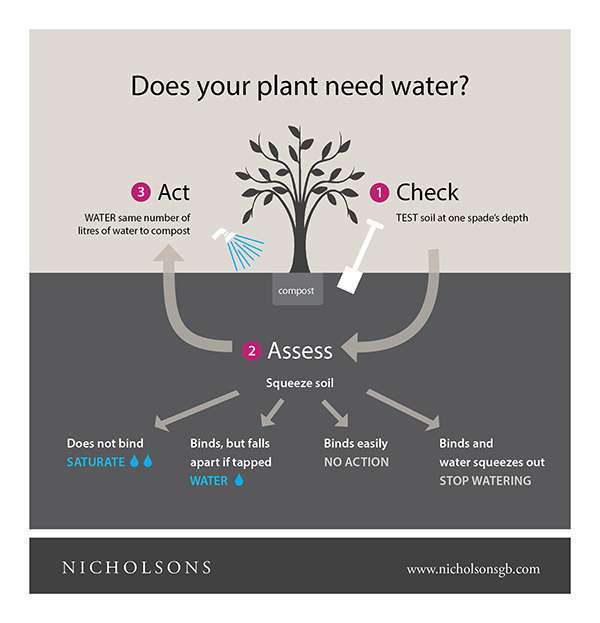How to Water Trees and Hedges
Watering Explained
In general terms it is best to let plants reach for their own water. It would have to be in extreme circumstances that we would recommend watering established planting.
Excess watering can lead to the formation of shallow roots and thereby creates a plant that is vulnerable to drought and wind.
Mulch
Any talk of watering should be prefaced by mulching. The use of mulch around the plant has two main benefits – not only does it suppress weeds, reducing competition and thereby giving the plant a better chance of growth, but it also retains moisture in the ground. Well-applied mulch will permit all available water to soak through to the roots and then prevent water loss through evaporation. We recommend that mulch be typically applied to a depth of around 7cms.
We use a lot of bark mulch in our planting and sell both fine bark and coarse. Available by the bag or in bulk, see the Sundries section on our website.
Hedges
Hedges massively benefit from the use of drip pipe. It is relatively cheap and will give a good result for establishment. Bark Mulch is also of great value and our experience suggests that soil under bark mulch will dry out up to eight weeks later than unprotected soil in a dry spell. The drip pipe should be installed prior to mulching and then covered. This ensures that the water reaches the soil quickly, is not subjected to evaporation, and that unsightly piping is hidden by the mulch.
Larger Planted Trees
During a typical warm summer, a tree with a one-meter canopy will require approximately 40-80 liters of water per week.
When planting a larger tree (taller than 3 meters) we recommend that a watering tube is included to ensure that any water given goes directly to the roots. The diagrams on our Planting Guidelines page on our website illustrates the principles and procedures.
After planting, trees will need watering once or twice per week, depending upon conditions, using a hosepipe or leaky bucket. This should be sufficient to wet the soil thoroughly, but not to the point of saturation – if in doubt, check with the Squeeze Test. Take a handful of soil at root level and squeeze it.
- If the soil doesn’t bind at all and falls readily through your fingers then water urgently.
- If the soil does bind but then crumbles when touched that’s just about okay but apply water and check again soon.
- If the soil binds and holds there is no need to water.
- If the soil binds and free water squeezes out it is too wet! Allow to dry out.
A dressing of Bark Mulch will reduce water loss from evaporation, and also act as a weed suppressant.
Smaller Planted Trees
In many cases where large numbers of smaller trees (less than 2 meters) have been planted, it may not be economically worthwhile to water them. Using a bowser can prove to be a very costly exercise, and yet may still not supply each plant with the appropriate amount of water. In such cases it may be more cost effective not to water at all, but simply to replace those few trees that fail.
Flower Beds
We always advise the use of mulch on a flower bed, not only to deter weeds, but also to help with water retention. To test a border for moisture, carefully scrape back the mulch and dig a hole 20 cms deep. Grip a handful of soil firmly in your hand and squeeze it.
Assess the soil using the Squeeze Test – see above. Flower and shrub borders will benefit from the use of drip pipe. This is easy to install and should lie discreetly under bark mulch. It requires a water pressure of approximately 1.5 bar to run a drip pipe of up to 700 meters in length. Most outside taps are between 2.0 and 4.0 bar. A typical drip pipe will have small holes every 50 cms and will deliver 2.3 liters of water per hole per hour. During a dry spell, assuming the soil is moist beneath the mulch, two hours of watering per week should be sufficient, but check the moisture content of the soil using the Squeeze Test just to make sure.
Grass
Water newly laid turf to full saturation until fully rooted – in other words, until you can no longer lift the turf with ease – test a small area. In warm dry weather turf will need daily watering until established.
Seeded areas of grass should not be watered in at all – rain is best. If rain is followed by a prolonged dry period, you may see the grass ‘chitting’ and then drying. In some case modest watering can be undertaken with a very light sprinkler, but only with great care. Once all of the grass seeds have germinated, it is then important to keep the seed bed moist until the seedlings have fully rooted.
Remember
Air in the soil is as vital as water, so don’t waterlog – too much water can be just as harmful as too little. Many plants will not tolerate sitting in water-saturated ground. Be especially careful with Taxus (yew) and Ilex (holly). If in any doubt, please ask.
Don’t be fooled by the rain – summer rain very often does not soak deeply into the ground but simply wets the surface and then evaporates, sometimes not even reaching the root ball. Occasionally the underlying soil can be very dry but the soil surface appears wet, especially after a heavy shower. If you are unsure, carry out the soil Squeeze Test, and see if your plants really need extra water.

If you would like any further information on watering, please don’t hesitate to on 01869 340342 or email us at plantsales@nicholsonsgb.com

